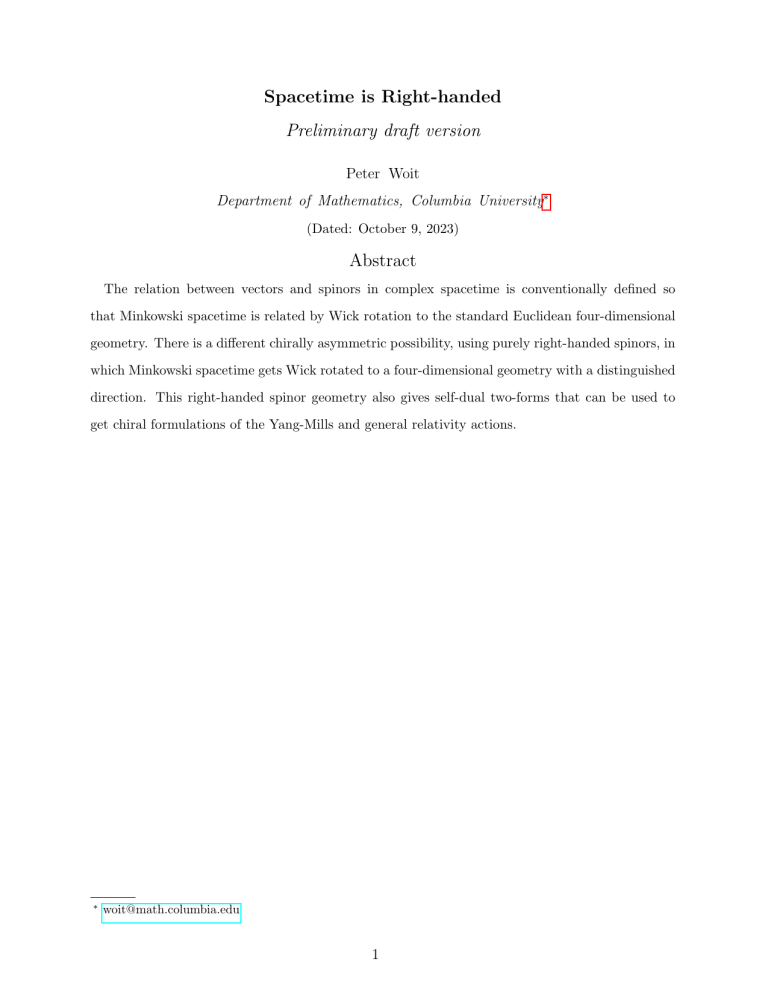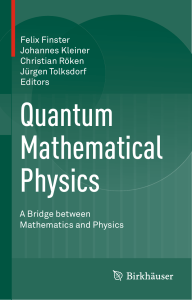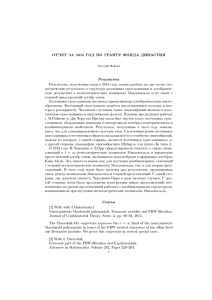
Spacetime is Right-handed Preliminary draft version Peter Woit Department of Mathematics, Columbia University∗ (Dated: October 9, 2023) Abstract The relation between vectors and spinors in complex spacetime is conventionally defined so that Minkowski spacetime is related by Wick rotation to the standard Euclidean four-dimensional geometry. There is a different chirally asymmetric possibility, using purely right-handed spinors, in which Minkowski spacetime gets Wick rotated to a four-dimensional geometry with a distinguished direction. This right-handed spinor geometry also gives self-dual two-forms that can be used to get chiral formulations of the Yang-Mills and general relativity actions. ∗ woit@math.columbia.edu 1 I. WICK ROTATION OF FOUR-DIMENSIONAL VECTORS AND SPINORS The Lorentz group SL(2, C) has two inequivalent spinor representations: the defining representation ( 12 ) on C2 and its conjugate ( 12 ). The corresponding spin group in Euclidean signature is the product group Spin(4) = SU (2)L × SU (2)R , with spinor representations ( 12 )L and ( 21 )R (meaning the defining representation on one factor, trivial representation on the other). In the SU (2) case the defining representation ( 12 ) is equivalent to its conjugate representation. The conventional way to Wick rotate between Minkowski and Euclidean signature spinors is to analytically continue using the complex group SL(2, C)L × SL(2, C)R , which is a complexification of both an SU (2)L × SU (2)R subgroup and the Lorentz SL(2, C) subgroup of pairs of the form (Ω, Ω). This has holomorphic representations ( 21 )L and ( 12 )R which restrict to SU (2) representations in the Euclidean case and to ( 21 ) and ( 12 ) in the Minkowski case. In the van der Waerden notation one writes coordinates for spinors as sA for those that transform under SL(2, C)L and dotted indices sȦ for those that transform under SL(2, C)R . Complex spacetime vectors can be built out of spinors as the tensor product ( 21 )L ⊗ ( 12 )R , giving a holomorphic representation of SL(2, C)L × SL(2, C)R on C4 , with coordinates X AȦ . Euclidean and Minkowski spacetime will be two real four-dimensional subspaces, preserved by SU (2)L × SU (2)R and the Lorentz group respectively. Lowering one set of indices, complex spacetime vectors are linear maps from ( 21 )∗R to ( 12 )L with a standard set of coordinates giving matrices of the form z + z3 z1 − iz2 0 z1 + iz2 z0 − z3 Then z1 , z2 , z3 , z0 real (Hermitian matrices) is Minkowski spacetime, taking z0 pure imaginary gives Euclidean spacetime. The use of this holomorphic representation of SL(2, C)L × SL(2, C)R to analytically continue Wightman functions and prove general theorems about their properties is described in [1]. Instead of this chirally symmetric analytic continuation, there is an alternate chirally asymmetric possibility that does not seem to have been previously considered. This is to identify the Lorentz group with the right-handed SL(2, C)R and complex spacetime with the tensor product ( 12 )R ⊗ ( 12 )R of spinor representations. This gives up the possibility of using the complex group SL(2, C)L × SL(2, C)R and holomorphic representations to do analytic 2 continuation, but one still has a complex spacetime in which one can analytically continue betwee real Minkowski and Euclidean subspaces. While SL(2, C) acts on Minkowski space in the usual way, something new happens on the Euclidean subspace. There is no SU (2)L acting, just an SU (2)R ⊂ SL(2, C)R . The ( 21 )R and ( 12 )R reps of SL(2, C)R are equivalent as representations of SU (2)R , so (complexified) Euclidean spacetime is 1 1 ⊗ = (0)R + (1)R 2 R 2 R There is a distinguished direction invariant under SU (2)R and a complementary threedimensional space transforming as a vector under SU (2)R . It appears possible that one can consistently do Euclidean quantum field theory in this new version of Euclidean spacetime. While one can reconstruct a physical state space from Minkowski spacetime Wightman functions in an SL(2, C)-covariant way, reconstruction of a physical state space from Euclidean spacetime Schwinger functions requires a choice of direction (one needs to restrict to positive imaginary time and use an Osterwalder-Schrader reflection, see [2]). In this right-handed complex spacetime version of Euclidean spacetime, the SU (2)L acts trivially, behaving like an internal symmetry. II. WICK ROTATING WEYL SPINOR FIELDS The Lagrangian density for a right-handed Weyl spinor degree of freedom in Minkowski spacetime is (in terms of momentum space fields) the SL(2, C) invariant e L = ψe† (p)(p0 − σ · p)ψ(p) where ψe is in the ( 21 ) representation. Solutions of the equation of motion have either • Positive energy p0 , so describe particles, and helicity + 21 . • Negative energy p0 , so describe anti-particles, and helicity − 21 . Here helicity is the eigenvalue of the operator 1σ·p 2 |p| As noted for instance in the textbook [3] (page 226), with the conventional identification of the Wick rotated Euclidean spacetime vector ip0 −σ·p as an element of the tensor product 3 ( 12 )L ⊗ ( 21 )R , there is no way to get an invariant Lagrangian density just using right-handed Euclidean Weyl spinors. One cannot construct a propagator for Euclidean spinor fields that transforms under Spin(4) as expected without using both chiralities of spinor. Even doing this, the conventional definition of Euclidean spinor fields involves an additional doubling of the number of degrees of freedom (see [4]). The formulation of Euclidean quantum field theory using a spacetime involving only right-handed spinor degrees of freedom avoids the problems above and makes it possible to construct a Euclidean spacetime quantum field theory describing right-handed Weyl spinor fields, without the necessity of introducing fields of the opposite (Euclidean) chirality. Note that, in Minkowski spacetime left-handed Weyl spinor fields can be constructed by conjugating right-handed Weyl spinor fields. The suggested Wick rotation for spinor fields of section I takes both right-handed and left-handed Minkowski spinors to right-handed Euclidean spinors. III. TWO-FORMS, SPINORS AND YANG-MILLS THEORY In four dimensions the Hodge dual takes two-forms to two-forms, satisfying ∗2 = 1 in Euclidean signature. Those with ∗ eigenvalue +1 are called self-dual, those with eigenvalue −1 are anti-self-dual. Using the inner product, two-forms can be identified with infinitesimal Spin(4) transformations, with self-dual two-forms corresponding to the Lie algebra of SU (2)R (so one could describe them as “right-handed” instead of “self-dual”) and anti-selfdual ones corresponding to the Lie algebra of SU (2)L . In Minkowski signature one has ∗2 = −1, so eigenvalues are ±i and there are no real self-dual or anti-self-dual forms. To get such forms, one needs to work with four complex dimensions and the complexified Lie algebras of SL(2, C)R and SL(2, C)L . Complexified self-dual two-forms are identified with the Lie algebra of SL(2, C)R , so are traceless maps from ( 21 )R to itself, so a three-complex dimensional space that can be identified with the symmetric part of the tensor product of two copies of ( 12 )R . Like complex one-forms (identified with ( 12 )R ⊗ ( 12 )R as in section I) they just involve the right-handed part of four-dimensional geometry. In the Euclidean version of Yang-Mills theory with gauge group G, the dynamical variables A are connections valued in the Lie algebra of G, with dynamics give by the Yang-Mills 4 action Z 1 1 2 |FA | = 2 T r(FA ∧ ∗F (A)) 4g 2 4g where FA is the curvature of A. Decomposing F into self-dual (FA+ ) and anti-self-dual (FA− ) R components, and using the fact that T r(FA ∧ FA ) is a topological invariant, an equivalent form of the action is Z 1 T r(FA+ ∧ ∗FA+ ) 2g 2 This action only involves self-dual two-forms, and thus only right-handed spacetime spinor geometry. IV. GENERAL RELATIVITY IN TERMS OF RIGHT-HANDED SPINOR VARI- ABLES It turns out that the dynamics of general relativity also can be formulated in a way that just involves right-handed spacetime. That this simplifies the theory considerably was shown in [5], which described a new canonical formulation in terms of variable now known as Ashtekar variables. These not only exploited the chiral description of four-dimensional spacetime, but also took as fundamental connection variables of the same sort as in YangMills theory. For a detailed treatment of chiral approaches to the formulation of general relativity, see [6]. One well-developed modern formalism for doing geometry and studying general relativity originates with Cartan. In this formalism one works with objects defined equivariantly on the frame bundle of a manifold rather than the manifold itself. This formalism allows a straight-forward definition of spinor fields and is rather close to the formalism of gauge theory. In gauge theory one starts with a principal G-bundle over a manifold M , with a connection and curvature described by Lie G-valued one and two-forms on P satisfying an equivariance condition under the action of G on P . The gauge theory formalism is very general, allowing G to be any Lie group, and it plays the role of an internal symmetry, unrelated to spacetime symmetry. The Cartan formalism is a special case of the gauge theory formalism, taking P as the bundle of orthonormal frames for a manifold with metric. G is then the orthogonal group acting on the frames. One can do spinor geometry naturally in this formalism, working with a spin double-cover of P and taking as group G the spin double-cover of an orthogonal 5 group. In four dimensions and the Euclidean signature, this is Riemannian geometry with G = SU (2)L × SU (2)R . With Minkowski signature, G is the Lorentz group SL(2, C). The frame bundle of a manifold is a very specific example of a principal bundle, with a group G that is not independent of the spacetime geometry, but defined by it. It comes with an additional structure one doesn’t have in the gauge theory case, a canonical one-form θ on the frame bundle that takes values in R4 . This one-form is sometimes called the tetrad oneform. At a point on the frame bundle, applied to a tangent vector, it gives the coordinates of the vector with respect to the frame. When G is the spin version of the frame bundle, the curvature two-form has remarkable properties, since it takes values in the Lie algebra of G, which is the same space as the space of two-forms. So (at a point) one can think of it as an endomorphism of a six dimensional space with a decomposition into two three-dimensional spaces. This has a block diagonal form, and the Einstein equations correspond to vanishing of the off-diagonal blocks (for details, see [7] or [6]). Much of the effort to exploit Ashtekar variables or other chiral formulations of general relativity has worked in Minkowski signature where one must complexify the tangent bundle and work with complex-valued connections and curvatures, then try to later impose reality conditions to get back to the real physical variables. For a Lagrangian version of such an action for complex general relativity, see [8], where such a Lagrangian is given as Z ΣȦḂ ∧ RȦḂ Here we are using van der Waerden notation, with Σ a self-dual two-form valued in the symmetric tensor product of two right-handed spinors that is constructed out of the oneform θ. RȦḂ is the curvature two-form, taking values in the dual to the symmetric product of right-handed spinors. Varying this action with respect to the connection gives the torsionfree (Levi-Civita) relation between the tetrad and the connection, while varying with respect to the tetrad gives the Einstein equations. In Euclidean signature spacetime with Riemannian geometry one can work with real variables and does not need to do this. There is a well-developed subject of Euclidean quantum gravity in which one attempts to start with a theory defined in Euclidean signature, and somehow later recover by analytic continuation the Minkowski signature theory. This has well-known problems (see for instance [9]), but perhaps the new purely right-handed 6 version of Euclidean geometry discussed in sections I and III might provide a different perspective. V. DISCUSSION The Standard Model quantum field theory is not well-defined in Minkowski spacetime without some further information, with analytic continuation from Euclidean spacetime one way to accomplish this. Defining the theory this way allows one to exploit the symmetries of the Euclidean spacetime, and in [10] we described a speculative proposal for understanding the symmetries of the Standard Model in terms of the geometry of the Euclidean version of twistor space. Such a twistor space description is inherently completely chirally asymmetric, with points in spacetime corresponding to spinors of one chirality. The most unconventional part of the proposal is that the part of the Euclidean rotation group that acts on the other chirality could physically correspond not to a spacetime symmetry but to an internal symmetry. The main goal of this paper has been to understand the possible origin of such a counter-intuitive phenomenon. Note however that mixing between Euclidean rotational symmetry and an internal symmetry has been seen in other contexts, in particular in the twisting used to define topological quantum field theories (see [11]) and in formulating N = 4 supersymmetry on the lattice (see section 8.2 of [12]). The conventional way of relating Euclidean and Minkowski spacetime spinors is by a chirally symmetric analytic continuation which takes Euclidean spacetime symmetries to Minkowski spacetime symmetries for both chiralities. In this paper we have proposed a different relation, which uses just one chirality. Spacetime (both Minkowski and Euclidean) can be said to be “right-handed”, and we see that this goes beyond the spin 1 2 matter degrees of freedom, with Yang-Mills and gravitational dynamics also described using right-handed spinors. A proposed “gravi-weak” unification, in which the Lorentz group is the right chiral half of an SL(2, C)L × SL(2, C)R symmetry, with the electroweak internal SU (2) in the other half has been made in [13] (see also [14], [15]). This proposal is set in Minkowski spacetime 7 and does not involve Euclidean spacetime or twistor geometry. [1] R. F. Streater and A. S. Wightman, PCT, Spin and Statistics, and All That (Princeton University Press, 2000). [2] K. Osterwalder and R. Schrader, Commun. math. Phys. 31, 83 (1973). [3] P. Ramond, Field Theory: A Modern Primer (Benjamin/Cummings, 1981). [4] K. Osterwalder and R. Schrader, Helvetica Physica Acta 46, 277 (1973). [5] A. Ashtekar, Phys. Rev. Lett 57, 2244 (1986). [6] K. Krasnov, Formulations of General Relativity (Cambridge University Press, 2020). [7] M. F. Atiyah, N. J. Hitchin, and I. M. Singer, Proc. R. Soc. Lond. A 362, 425 (1978). [8] R. Capovilla, J. Dell, T. Jacobson, and L. Mason, Classical and Quantum Gravity 8, 41 (1991). [9] G. Gibbons, in Workshop on Conference on the Future of Theoretical Physics and Cosmology in Honor of Steven Hawking’s 60th Birthday (2002) pp. 351–372. [10] P. Woit, Euclidean twistor unification (2021), arXiv:2104.05099 [hep-th]. [11] E. Witten, Communications in Mathematical Physics 117, 353 (1988). [12] S. Catterall, D. B. Kaplan, and M. Ünsal, Physics Reports 484, 71 (2009). [13] F. Nesti and R. Percacci, Journal of Physics A: Mathematical and Theoretical 41, 075405 (2008), arXiv:0706.3307 [hep-th]. [14] S. Alexander, Isogravity: Toward an electroweak and gravitational unification (2007), arXiv:0706.4481 [hep-th]. [15] S. Alexander, A. Marcianò, and L. Smolin, Phys. Rev. D 89, 065017 (2014). 8

